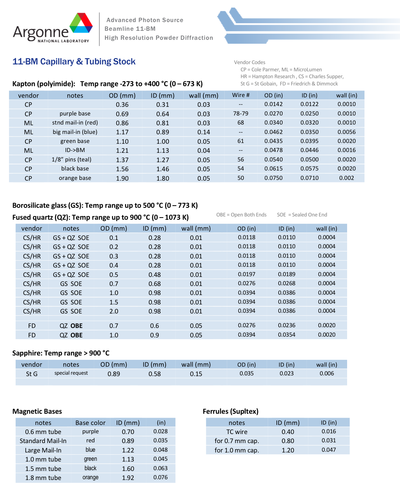Capillary Tubes
moved: see
https://wiki-ext.aps.anl.gov/ug11bm/index.php/Supplies_and_Tools
Mail-in Users
Glass & fused quartz
Specific mail-in samples (for example air sensitive material) may require the use of additional glass or fused quartz capillary tubes. Any additional capillary must fit and be secured inside the supplied Kapton tube.
11-BM does not provide glass or quartz capillaries for mail-in experiments. Only Kapton tubes (with an inner diameter of 0.81 mm) are provided for the mail-in service.
To purchase tubes, domestic users are referred to the vendors below for glass ('special' or 'borosilicate') or quartz capillaries. Tubes with diameter of 0.5 mm or 0.7 mm are recommended. As purchased from both vendors, the tubes are pre-sealed on one end, and have a flared opening on the other end for easy powder loading.
Charles-Supper (http://www.charles-supper.com/en/page/category.cfm?idCategory=13)
Hampton Research (http://hamptonresearch.com/menus.aspx?id=3&sid=110)
Glass and quartz are both stable over the temperature range available via the mail-in service. Glass adds a bit smaller background to the diffraction pattern and is easier to seal, but fused quartz tubes are stronger and more likely to survive shipping and handling.
Due to small variations glass or quartz tube sizes, the 0.7 mm diameter size can be a tight fit in 0.8 mm Kapton tubes, but they usually fit.
Smaller tubes (e.g 0.3 mm) may be useful to lower X-ray absorption,
When returning samples loaded in glass capillaries, please leave a note in the package so we be sure to take extra care when handling.
Kapton
We have used the following suppliers for Kapton tubing:
- MicroLumen, Inc. (http://www.microlumen.com/)
- Cole-Parmer (http://www.coleparmer.com/catalog/product_index.asp?cls=6806)
The MicroLumen company can make almost any size you need, and is happy to send samples as well. Cole Parmer has a list of different available sizes on the webpage, and you might be able to find the Cole-Parmer brand on Fisher Scientific or a similar supply company.
On-Site Users
A selection of Kapton, Glass and fused Quartz capillary tubes are available at 11-BM for on-site experiments. Check with staff to confirm, but the materials and dimensions shown below are typically on hand.
Use quartz for high temperature work ( > 450 C). Glass adds a bit smaller background to the diffraction pattern and is easier to seal, but fused quartz tubes are stronger, more chemical resistant, and survive higher temperatures.
